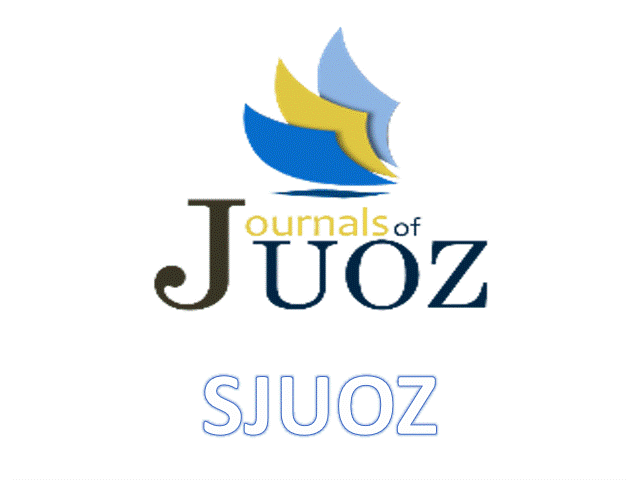Evaluation of the Rocks of The Pila Spi Formation of Duhok Anticline For Building Stones – Kurdistan Region Of Iraq
DOI:
https://doi.org/10.25271/sjuoz.2021.9.4.837Keywords:
Building Stones, Duhok Anticline, Kurdistan Region, Physico-mechanical Properties, Pila Spi Formation, QuarryingAbstract
The rocks of the Pila Spi Formation at the southern limb of the Duhok anticline have been evaluated for use as building stones. The geology of the area and examined rocks are described. Nine samples were collected and tested for physico-mechanical properties (total porosity, water absorption, saturation coefficient, apparent specific gravity, bulk density and uniaxial compressive strength). There was a remarkable variation between the samples in these properties, which showed very high significant relationships with each other. Samples were classified as frost-resistant. According to the Iraqi and American Standards, four samples were categorized as (low density/acceptable), three samples as (moderate density/recommended) and two samples as (high density/highly recommended). According to some classifications, the samples were (moderately strong) except for two of them were (strong), while all of them were (moderately strong) and (high strength rocks) in other classifications. The examined rocks are suitable for interior and exterior wall cladding and exterior fencing, as well as for decoration. Four of them are not suitable for building sections that require high load bearing or in places where they come into contact with water or soil, such as foundations, while only two samples are suitable. The quality and quantity of the rocks and the quarrying conditions encourage their exploitation for building stones, with the necessity of proper planning of the proposed quarry and special treatment during quarrying.
Downloads
References
S.M. (2015): Effect of Petrographical Characteristics on the Engineering Properties of Some Egyptian Ornamental Stones. International Journal of Scientific and Engineering Research, Volume 6, Issue 7, pp.116 – 123.
Al-Banna, A.Sh., Ali, Dh.Kh. and Abdullah, H.H. (2013): Characteristics
of Some Geotechnical Properties of Pilaspi and Injana Sedimentary Formations, at Shaqlawa Area, North Iraq. International Journal of Civil Engineering and Technology. Vol.4, Issue 6, pp.252 – 260.
Ali, M.H.; Hijab, B.R. and Al-Jassar, S.H. (1991): Engineering Geology.
Dar Al-Kutub for Printing and Publishing, University of Mosul, 572 p. (in Arabic).
Al-Jiburi, H. and Al-Basrawi, N. (2013): Hydrogeological Map of Iraq,
Scale 1:1000000. 2nd ed. Baghdad, Iraq: Iraq Geological Survey Publications.
Alkadum, N.A.A. (2009): Structure of Dohuk Anticline-Northern Iraq its
Tectonic Implications. Unpublished M.Sc. Thesis, University of Basrah, 140 p.
Al-Saraj Bashi, M.S. (2017): Mathematical Interpolations for the
Geometry and Structure of Dohuk Syncline and its Hydrogeological Investment, Northern Iraq. Unpublished M.Sc. Thesis, University of Mosul, 100 p.
American Society for Testing and Materials, ASTM C170–90 (1999):
Standard Test Method for Compressive Strength of Dimension Stone. Annual Book of ASTM Standards. Vol. 04.07.3 p.
American Society for Testing and Materials, ASTM C568-03 (2006):
Standard Specification for Limestone Dimension Stone. Annual Book of ASTM Standards. Vol.04.07. 2 p.
American Society for Testing and Materials, ASTM C97–09 (2010):
Standard Test Method for Absorption and Bulk Specific Gravity of Dimension Stone. 3 p.
Anon. (1977): The Description of Rock Masses for Engineering
Purposes.Working Part Report of the Engineering Group of the Geological Society of London. Quarterly Journal of Engineering Geology, Vol. 10, pp. 355 – 388.
Barbaro, C.C. and Moscone, D. (2020): Going to the Source: New
Perspectives in the Study of the Canaanean Blade Technology from Iraqi Kurdistan. In: Manclossi F.; Marchand, F.; Boutoille L., and Cousseran-Néré S. eds., Stone in Metal Ages. Archaeopress, Oxford, pp.52 – 63.
Bhattarai, S. and Tamrakar, N.K. (2017): Physical Properties, Strength and
Durability of Selected Rocks from the Central Nepal Lesser Himalaya, Malekhu River Area for Building Stones. American Scientific Research Journal for Engineering, Technology, and Sciences, Vol.35, No.1, pp.236 – 250.
British Geological Survey (2005): Building and Roofing Stone. Mineral
Profile, Natural Environment Research Council, 24 p.
Broch, E. and Franklin, J.A. (1972): Point-load strength Test. Int. J. Rock
Mech. Min. Sci. 9 (6), 669–697.
Dhaher, K. A. (2009): Study of Physical and Geotechnical Properties of
Some Rock Units of Pilaspi, Fatha and Injana Formations in Shaqlawa Area, Northern Iraq. Unpublished M.Sc. Thesis, College of Science, University of Baghdad, Iraq.
Fouad, S.F. (2015): Tectonic Map of Iraq, scale 1:1000000 m 3rd edition,
Iraq Geological Survey Publications, Baghdad, Iraq.
Franklin, J.A. and Dusseault, M.B. (1989): Rock Engineering. McGraw-
Hill, New York, 600 p.
Geological Society Engineering Group Working Party (1977): The
Description of Rock Masses for Engineering Purposes. Report. Q J Eng Geol 10:43–52.
Griffin, J.A. (2008): Development of a Rating Classification for Rock to be
Used as Toe-Bench Material. Unpublished M.Sc. Thesis, Kent State University, 131p.
Honeyborne, D.B. (1982): The Building Limestones of France (Building
Research Establishment Report). H.M.S.O., 116 p.
Iraqi Standard Specification No.2715–1987: Test Method for Compressive
Strength of Natural Stone. Central Agency for Standardization and Quality Control, Ministry of Planning, Baghdad. (in Arabic).
Iraqi Standard Specification No.1387–1989: Natural Building Stone.
Central Agency for Standardization and Quality Control, Ministry of Planning, Baghdad. (in Arabic).
ISRM - International Society for Rock Mechanic - Commission on the
Classification of Rocks and Rock Masses (1981): Basic Geotechnical Description of Rock Masses. Int. J. Rock Mech. Min Sci. Geomech. Abstr., 18:85–110.
Jassim, S.Z. and Goff, J.C. (2006): Geology of Iraq. Published by Dolin,
Prague and Moravian Museum, Brno, Czech Republic, 341 p.
Karim, K.H. and Hama, B.A. (2019): Chronicle of the Oligocene
Succession (Kirkuk Group) in Duhok Governorate, Kurdistan Region, North Iraq. Journal of Zankoy Sulaimani, Vol.21, No.1, pp.75 – 90.
Khattab, S.I. and Othman, H.M.S. (2012): Durability and Strength of
Limestone Used in Building. Al-Rafidain Engineering Journal, Vol.21, No.3, pp.1 – 14.
McMillan, A.A., Gillanders, R.J. and Fairhurst, J.A. (1999): Building
Stones of Edinburgh. 2nd edn, Edinburgh Geological Society, Edinburgh.
Mirza, T.A. and Rashid, S.Gh. (2019): Evaluation of the Pila Spi
Formation Carbonate Rocks for Dimension Stone, Qara Dagh Area, Kurdistan Region, NE Iraq. Iraqi Bulletin of Geology and Mining, Vol.15, No.2, pp.107 – 120.
Moscone, D., Eramo, G., Caggiani, M.C., Morandi Bonacossi, D. and
Conati Barbaro, C. (2020): Compositional Features of Cherts from the Jebel Zawa Mines (Dohuk, Kurdistan Region of Iraq) and Implications for Exploitation Strategies during the Late Chalcolithic/Early Bronze Age. Journal of Archaeological Science: Report 29 (2020), 18 p.
Omar, H.M. and Ismail, N.R. (2015): The Suitability of Limestone from
Pilaspi Formation (Middle – Late Eocene) for Building Stone in Koya Area, NE Iraq. ARO, the Scientific Journal of Koya University, Vol.3, No.2, pp.18 – 23.
Quick, G.W. (2002): Selective Guide to the Specification of Dimension
Stone. CSIRO Building, Construction and Engineering, Highett, Victoria, Australia, 9 p.
Saffet, Y. (2010): Geomechanical Properties of Construction Stones
Quarried in Southwestern Turkey. Scientific Research and Essays. Vol.5, No.8, pp.750 – 757.
Saleh, Dh.Gh. (2012): The Suitability of Limestone of Fat'ha Formation
for Building and Road Aggregates in Nineveh Governorate/North Iraq. Journal of Al-Anbar University for Pure Sciences, Vol.6, No.3, pp.1 – 13.
Sandrolini F. and Franzoni E. (2006): An Operative Protocol for Reliable
Measurements of Moisture in Porous Materials of Ancient Buildings. Build Environ; 41:1372–80.
Sharma, P.K., Khandelwal, M. and Singh, T.N. (2006): Effect of Acidic
Water on Physio-Mechanical Properties of Building Stone - A Case Study. IAEG 2006 paper number 51, pp.1 – 7.
Sissakian, V.K., Hagopian, D.H. and Hasan, E.A. (1995): Geological Map
of Al-Mosul Quadrangle - Sheet NJ – 38 – 13, scale 1:250.000, Iraq Geological Survey Publications, Baghdad, Iraq.
Spry, A.H. (1989): Stone Testing: General; In Perry, J.; Spry, A. H. and
West, D. (eds), Stone in Modern Building: State of the Art. Seminar Notes, Sydney, 23 – 24 October, 1989, pp.45-57.
Taylor, J. and Harold, A. (1991): A. “Annual Report of Dimensional
Stones”. U.S Department of Interior, Bureau of Mines, 18 p.
Zeb, A. (2009): Prediction of Effective Thermal Conductivity of Fluid
Saturated Porous Media: in situ Thermo Physical Measurements. Ph.D. Thesis, Quaid-i-Azam University, Pakistan, 139 p.
Google Earth Pro V.9.145.0.2. (August 08, 2020). Sharya District, Duhok,
Iraq. 36° 48' 40" N, 43° 01' 27" E, elev 1981 ft. eye alt 7513 ft. [Accessed October 8, 2021].
Downloads
Published
How to Cite
Issue
Section
License
Copyright (c) 2021 Ameer H. Khalid

This work is licensed under a Creative Commons Attribution 4.0 International License.
Authors who publish with this journal agree to the following terms:
- Authors retain copyright and grant the journal right of first publication with the work simultaneously licensed under a Creative Commons Attribution License [CC BY-NC-SA 4.0] that allows others to share the work with an acknowledgment of the work's authorship and initial publication in this journal.
- Authors are able to enter into separate, additional contractual arrangements for the non-exclusive distribution of the journal's published version of the work, with an acknowledgment of its initial publication in this journal.
- Authors are permitted and encouraged to post their work online.








